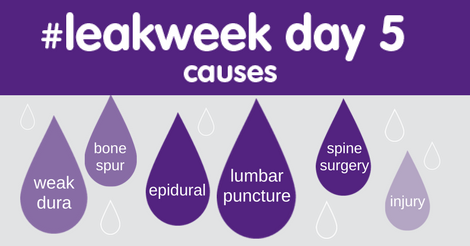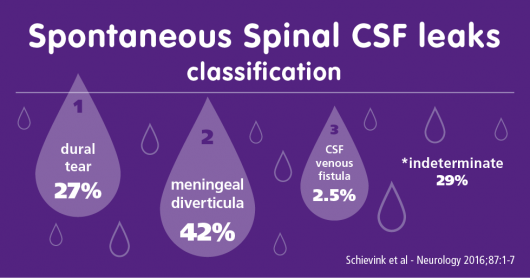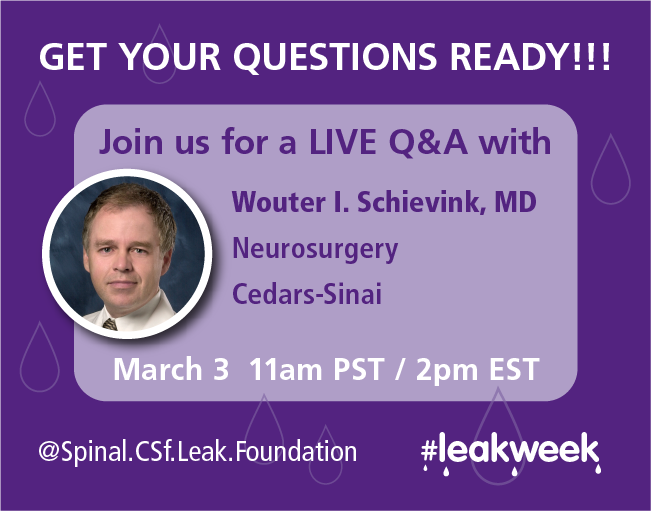Today is DAY 5 of Spinal CSF Leak Awareness Week.
We will focus today on Causes and Classification of spinal cerebrospinal fluid (CSF) leak, also known as intracranial hypotension.
Causes
There are 3 main causes of spinal CSF leak:
• Medical procedures (lumbar puncture or spinal tap, spinal surgery, labor epidural, other epidural injections)
• Injuries
• Spontaneous (this is the category where the diagnosis is often delayed or missed)
Most common cause (medical procedure: lumbar puncture)
The most common cause of a spinal CSF Leak is from the relatively common medical procedure, a lumbar puncture (LP) often known as a “spinal tap”. Studies have shown that there are several factors that influence the risk of a headache after a lumbar puncture (post-dural puncture headache):
– experience of the clinician performing the procedure
– size of the needle
– type of needle (sharp or cutting versus pencil-tip or non-cutting)
Another cause (medical procedure: labor epidural)
Another common cause of spinal CSF leak is related to epidural anesthesia, commonly performed during labor. Can you imagine coming home to your husband and 5 year-old son with your newborn son AND a severe headache when upright? Imagine trying to take care of your family when being upright results in excruciating head pain, nausea and other symptoms. This is Audrey’s story of her spinal CSF leak caused by a labor epidural. Read MORE here.
Spontaneous spinal CSF leak
The spontaneous type of spinal CSF leak, is presumed to be less common than those resulting from medical procedures, but due to the tendency for this to remain unrecognized, we really do not know the true incidence.
There are two recognized underlying causes
• Weaker than normal dura (normally tough layer that holds CSF in around the spinal cord), often in association with heritable disorders of connective tissue, including Ehlers-Danlos Syndrome, Marfan syndrome and others. Polycystic kidney disease is another hereditary disease that affects connective tissue and is associated with spontaneous leaks.
• Bony spurs along the spine can tear the dura
(both factors may be present in some patients)
Traumatic spinal CSF leak
Sports injuries, falls or motor vehicle accidents may result in a dural tear. These can be associated with bone spurs as well.
To learn more about the known causes of spinal CSF leak, visit our information page on Causes and review our document on>> Spinal CSF Leak Causes
Classification of spontaneous spinal CSF leaks
There are a number of different types of spontaneous spinal CSF leaks based on location and the presence or absence of fluid collections outside the dura (extradural). Treatment approaches differ according to the type and location of the leak.
Type 1 – Dural tear – extradural fluid collection in almost all
1a – ventral CSF leaks
1b – posterolateral CSF leaks
Type 2 – meningeal diverticula – extradural CSF collection in 22%
2a – simple diverticula
2b – complex meningeal diverticula/dural ectasia
Type 3 – CSF-venous fistulas – extradural CSF collections absent
Type 4 – Indeterminate – extradural CSF collections were noted in 51.5%
You may wish to download our document on the>> Classification of Spontaneous Spinal CSF Leaks .
Tomorrow we will focus on Treatment.
Visit our facebook page this evening to see photos of landmarks and buildings that will shine purple in honor of #leakweek.
K & D Terminal Tower – Cleveland, OH
Rundel Memorial Building – Rochester, NY
Building Owners and Managers Association (BOMA) of Chicago – Chicago, IL
King & Queen Buildings at Concourse – Atlanta, GA
Don’t miss today’s Expert LIVE Q & A session with Dr. Ian Carroll at 11 am PST / 2 pm EST on our facebook page and mark your schedule for the session tomorrow with Dr. Wouter Schievink.




